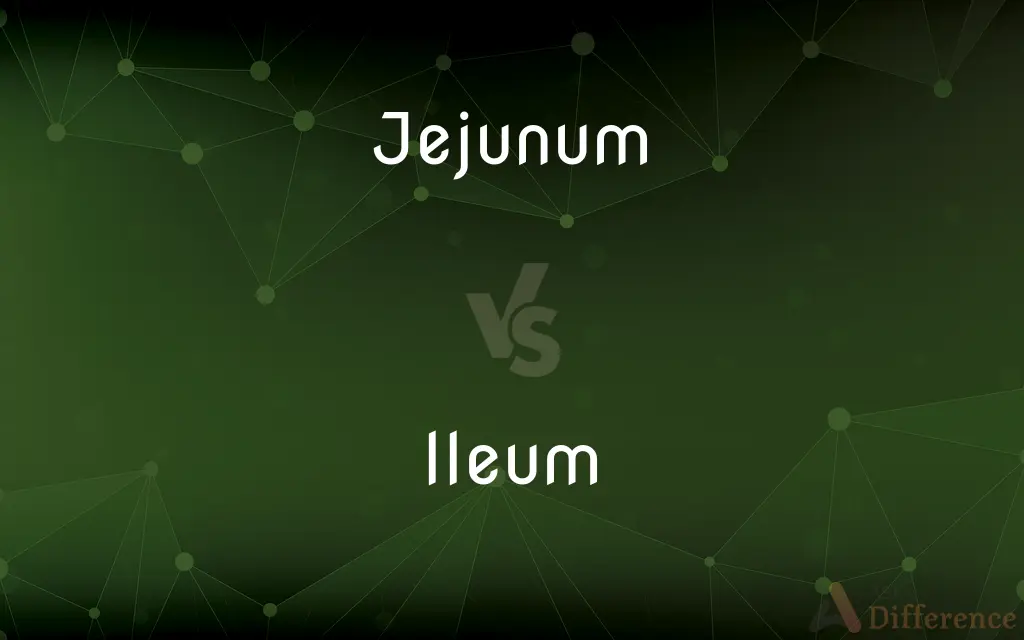Jejunum vs. Ileum — What's the Difference?
By Tayyaba Rehman & Maham Liaqat — Updated on March 15, 2024
The jejunum is the middle section of the small intestine, focusing on nutrient absorption, whereas the ileum is the final part, specializing in vitamin B12 absorption and bile acid reabsorption.

Difference Between Jejunum and Ileum
Table of Contents
ADVERTISEMENT
Key Differences
The jejunum and ileum are integral parts of the small intestine, each playing crucial roles in digestion and absorption. The jejunum, positioned between the duodenum and ileum, is primarily responsible for the absorption of nutrients and minerals from digested food. On the other hand, the ileum, located after the jejunum, focuses on the absorption of vitamin B12, bile salts, and any remaining nutrients not absorbed by the jejunum.
The lining of the jejunum is designed to maximize nutrient absorption, featuring numerous folds, villi, and microvilli. This structural complexity significantly increases the surface area for absorption. Whereas the ileum also has villi and microvilli, its lining is slightly less specialized but contains more lymphoid tissue (Peyer's patches) to protect against bacteria in the gut.
Blood supply and nerve innervation differ between the jejunum and ileum. The jejunum receives blood from the jejunal arteries, branches of the superior mesenteric artery, ensuring a rich blood supply for nutrient absorption. In contrast, the ileum's blood is supplied by both the ileal arteries (also branches of the superior mesenteric artery) and the ileocolic artery, reflecting its role in absorption and its transitional position to the large intestine.
The jejunum's wall is thicker due to its extensive absorption tasks, and its mucosa is more heavily folded. The ileum's wall is comparatively thinner, with fewer folds in the mucosa, adapting to its specific absorption functions and the need to transfer contents to the large intestine.
The jejunum is key in absorbing carbohydrates, proteins, fats, and most water-soluble vitamins, utilizing its extensive surface area. The ileum completes the absorption process, focusing on vitamin B12, bile acids necessary for fat digestion, and any remaining nutrients. This division of labor ensures efficient nutrient uptake before the chyme moves into the large intestine.
ADVERTISEMENT
Comparison Chart
Position
Middle section of the small intestine
Final section of the small intestine
Main Function
Absorption of nutrients and minerals
Absorption of vitamin B12, bile salts, and remaining nutrients
Structural Features
Thicker walls, more folds, villi, and microvilli
Thinner walls, fewer folds, more lymphoid tissue
Blood Supply
Supplied by jejunal arteries
Supplied by ileal and ileocolic arteries
Histological Differences
Extensively folded mucosa for increased absorption
Less folded mucosa with more Peyer's patches for bacterial protection
Compare with Definitions
Jejunum
The jejunum is the section of the small intestine responsible for nutrient absorption.
Most digested food particles are absorbed in the jejunum.
Ileum
The ileum completes the absorption of remaining nutrients.
Any nutrients not absorbed by the jejunum are taken up in the ileum.
Jejunum
The jejunum's main role is in the absorption of carbohydrates, fats, and proteins.
Enzymes in the jejunum break down food for nutrient absorption.
Ileum
The ileum is the final part of the small intestine, absorbing vitamin B12 and bile acids.
Bile acids reabsorbed in the ileum aid in fat digestion.
Jejunum
It is located between the duodenum and ileum.
The jejunum processes food matter after it exits the duodenum.
Ileum
It contains Peyer's patches for immune defense.
The ileum's lymphoid tissue protects against gut bacteria.
Jejunum
It features a highly folded lining to increase surface area.
The jejunum's folds are crucial for maximizing nutrient uptake.
Ileum
It connects to the large intestine at the ileocecal valve.
The ileum controls the flow of material into the large intestine.
Jejunum
The jejunum receives a rich blood supply for nutrient transport.
Blood from the jejunal arteries delivers nutrients absorbed by the jejunum.
Ileum
The ileum's blood supply includes the ileocolic artery.
Nutrients absorbed in the ileum are carried away by blood vessels.
Jejunum
The jejunum is the second part of the small intestine in humans and most higher vertebrates, including mammals, reptiles, and birds. Its lining is specialised for the absorption by enterocytes of small nutrient molecules which have been previously digested by enzymes in the duodenum.
Ileum
The ileum () is the final section of the small intestine in most higher vertebrates, including mammals, reptiles, and birds. In fish, the divisions of the small intestine are not as clear and the terms posterior intestine or distal intestine may be used instead of ileum.
Jejunum
The section of the small intestine between the duodenum and the ileum.
Ileum
The third portion of the small intestine, between the jejunum and the caecum.
Jejunum
(anatomy) The central of the three divisions of the small intestine which lies between the duodenum and the ileum
Ileum
The terminal portion of the small intestine extending from the jejunum to the cecum.
Jejunum
The part of the small intestine between the duodenum and the ileum
Ileum
(anatomy) The last, and usually the longest, division of the small intestine; the part between the jejunum and large intestine.
Ileum
The last, and usually the longest, division of the small intestine; the part between the jejunum and large intestine.
Ileum
See Ilium.
Ileum
The part of the small intestine between the jejunum and the cecum
Common Curiosities
What nutrients are primarily absorbed in the jejunum?
The jejunum primarily absorbs carbohydrates, proteins, fats, and most water-soluble vitamins.
Why is the ileum important for vitamin B12 absorption?
The ileum contains specific receptors that allow for the absorption of vitamin B12, essential for red blood cell formation.
What is the main function of the jejunum?
The jejunum's main function is the absorption of nutrients and minerals from digested food.
What is the significance of the blood supply to the jejunum and ileum?
A rich blood supply enables the transport of absorbed nutrients from the jejunum and ileum to the rest of the body.
What structural features aid the jejunum in nutrient absorption?
The jejunum has a highly folded lining with numerous villi and microvilli to increase its surface area for absorption.
Can the ileum absorb other nutrients besides vitamin B12 and bile acids?
Yes, the ileum absorbs any remaining nutrients not absorbed by the jejunum, including some water-soluble vitamins and minerals.
How do the jejunum and ileum contribute to immune defense?
While both contribute, the ileum has more Peyer's patches, lymphoid tissue that protects against bacteria in the gut.
How does the ileum differ from the jejunum in terms of structure?
The ileum has thinner walls, fewer folds, and more lymphoid tissue compared to the jejunum.
What role do Peyer's patches play in the ileum?
Peyer's patches are part of the immune system, helping to protect the body from harmful bacteria present in the gut.
How does the body compensate if part of the jejunum is removed?
The body can adapt by increasing absorption efficiency in the remaining parts of the small intestine, though nutrient absorption may be impacted.
How do the histological differences between the jejunum and ileum reflect their functions?
The jejunum's thicker, more folded mucosa maximizes nutrient absorption, while the ileum's structure supports vitamin B12 absorption and immune defense.
Is there a difference in the types of enzymes found in the jejunum and ileum?
Both sections contain digestive enzymes, but their specific activity levels and types may vary to optimize the local absorption processes.
Share Your Discovery

Previous Comparison
Are vs. Do
Next Comparison
Travel vs. TourismAuthor Spotlight
Written by
Tayyaba RehmanTayyaba Rehman is a distinguished writer, currently serving as a primary contributor to askdifference.com. As a researcher in semantics and etymology, Tayyaba's passion for the complexity of languages and their distinctions has found a perfect home on the platform. Tayyaba delves into the intricacies of language, distinguishing between commonly confused words and phrases, thereby providing clarity for readers worldwide.
Co-written by
Maham Liaqat














































